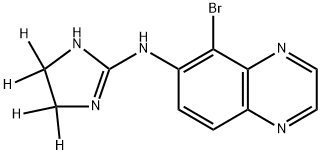Description
Brimonidine-d
4 is intended for use as an internal standard for the quantification of brimonidine by GC- or LC-MS. Brimonidine is an agonist of α
2-adrenergic receptors (α
2-ARs; K
is = 2.7, 52, and 44 nM for α
2A, α
2B, and α
2C-ARs, respectively, in CHO cells).
1 It is selective for α
2-ARs over α
1-ARs (K
i = 1,800 nM in human brain). Brimonidine lowers intraocular pressure in DBA/2J mice, a model of glaucoma, to control levels when applied topically to the eye as a 0.1% solution.
2 It also inhibits glutamate release, prevents upregulation of NMDA receptors containing NR1 and NR2A subunits, and protects rat retinal ganglion cells against glutamate excitotoxicity in a rat model of retinal ischemia when administered at a dose of 1 mg/kg per day.
3 Formulations containing brimonidine have been used in the treatment of open-angle glaucoma and ocular hypertension.
References
1. Munk, S.A., Harcourt, D.A., Arasasingham, P.N., et al.
Synthesis and evaluation of 2-(arylamino)imidazoles as α2-adrenergic agonists J. Med. Chem. 40(1),18-23(1997).
2. Sawada, K., Hiraoka, M., and Ohguro, H.
Effect of antiglaucoma medicine on intraocular pressure in DBA/2J mice Ophthalmic Res. 55(4),205-211(2016).
3. Lee, D., Kim, K.Y., Noh, Y.H., et al.
Brimonidine blocks glutamate excitotoxicity-induced oxidative stress and preserves mitochondrial transcription factor A in ischemic retinal injury PLoS One 7(10),e47098(2012).
